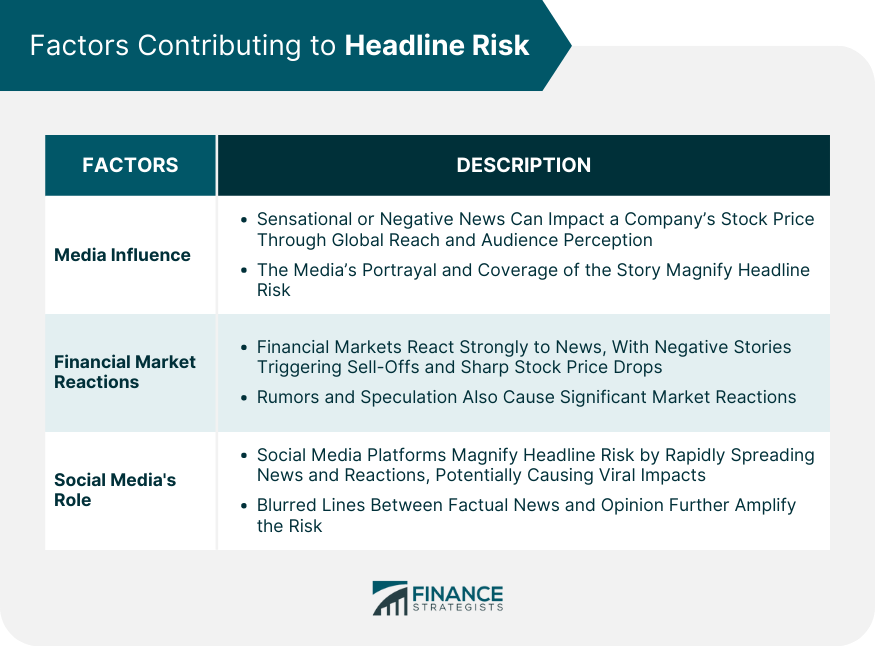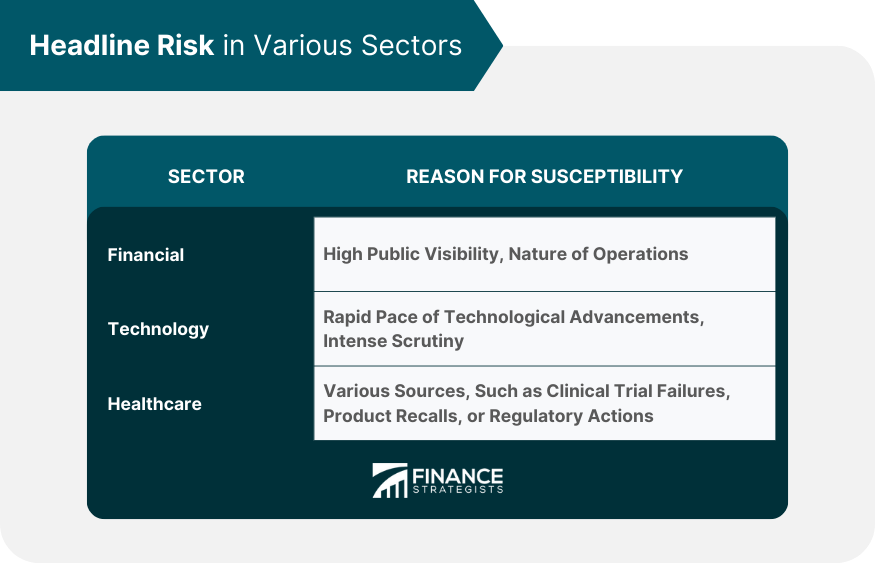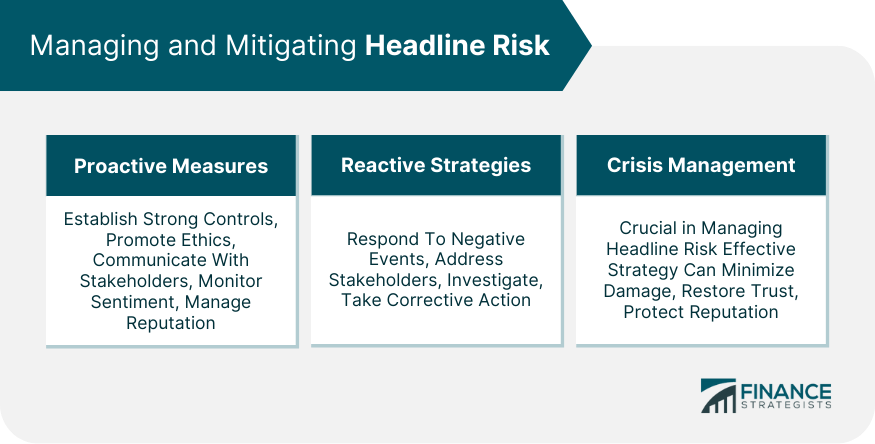Headline risk, as the name suggests, revolves around the potential negative impact that adverse news headlines can have on a company's financial condition or reputation. It's the risk that a news story will adversely affect a company's stock price and its financial performance. Even the anticipation of such news can cause investors to sell off shares and can lead to instability in a company's stock price. In our interconnected world, where news spreads rapidly across various platforms, the magnitude of headline risk has significantly increased. With the advent of social media and 24-hour news cycles, information—be it positive or negative—spreads quickly, reaching millions of people in seconds. Hence, companies are more vulnerable than ever to the effects of negative news and the subsequent headline risk it can create. For investors and stakeholders, understanding headline risk is crucial. It's an inherent part of investing and doing business. Media plays a crucial role in influencing headline risk. A news story, once published or aired, can instantly reach a global audience, affecting perceptions and attitudes towards a company. The more sensational or negative the news, the greater the potential impact on the company's stock price. Whether it's a product recall, a scandal involving a company executive, or financial irregularities, the way the media portrays and covers the story can significantly elevate the headline risk. Financial markets are often highly reactive to news, and the impact of headline risk is particularly prominent here. A negative news story can trigger a sell-off of a company's shares, leading to a sharp drop in its stock price. Even rumors or speculation can cause significant market reactions, highlighting the sensitivity of financial markets to headline risk. The advent of social media platforms has amplified headline risk exponentially. News—and more importantly, reactions to it—spread faster than ever before. With millions of users, a single post or tweet can quickly become viral, magnifying the impact of a negative news story. In addition, the blurring of lines between factual news and opinion on social media platforms can further exacerbate headline risk, as misinformation and speculation can spread rapidly and uncontrollably. The financial sector is notably susceptible to headline risk due to the nature of its operations and its high public visibility. News about financial irregularities, regulatory investigations, or significant changes in management can lead to substantial volatility in a financial institution's stock price. For instance, the Wells Fargo account fraud scandal in 2016 severely tarnished the bank's reputation and affected its stock price. The technology sector is also significantly influenced by headline risk. Given the rapid pace of technological advancements, companies in this sector often face intense scrutiny. News about data breaches, privacy concerns, or regulatory actions can quickly damage a tech company's reputation and market value, as seen with the Facebook-Cambridge Analytica scandal. In the healthcare sector, headline risk can emerge from various sources, such as clinical trial failures, product recalls, or regulatory actions. One notable example is the headline risk faced by Johnson & Johnson, associated with allegations of asbestos in their talc products. The news led to substantial legal repercussions and damage to the company's reputation. Quantitative approaches involve the use of statistical models and other numerical methods to measure headline risk. This could involve analyzing the volatility of a company's stock price in response to news events or using machine learning algorithms to quantify the sentiment of news articles or social media posts about the company. Qualitative approaches may involve analyzing the content of news stories, considering the reputation of the news source, the severity of the reported issue, and the company's response. Crisis management experts and public relations professionals often play a key role in this qualitative analysis. Measuring headline risk is challenging due to its inherently unpredictable and subjective nature. The impact of a news story can vary greatly depending on a multitude of factors, including the current market sentiment, the nature of the news, and the company's response. Moreover, the rise of social media has made it even more difficult to control or predict the spread of news. Proactive measures include establishing robust internal controls, fostering a culture of ethical behavior, and maintaining open lines of communication with stakeholders. Companies can also monitor media sentiment and engage in reputation management to anticipate and mitigate potential headline risks. Reactive strategies are employed after a negative event occurs. These might include crisis management strategies, such as immediately addressing the issue with stakeholders, launching an internal investigation, and taking corrective actions. Crisis management plays a crucial role in managing headline risk. An effective crisis management strategy can help minimize the damage of a negative news event, restore stakeholder trust, and protect the company's reputation. Headline risk can significantly influence investor decisions. Negative news can lead to a sell-off from investors, resulting in a decrease in the company's stock price. Conversely, positive news can attract investors, leading to an increase in the stock price. Investors' perceptions and reactions to headline risk can vary widely. Some investors might see a negative news event as a temporary setback and a buying opportunity, while others might view it as a sign of deeper problems within the company. Behavioral finance, which studies the influence of psychology on financial decision-making, can provide valuable insights into how investors respond to headline risk. It suggests that investors often react emotionally to the news, which can lead to overreactions and herd behavior in the financial markets. Headline risk is a growing concern in today's fast-paced world, where negative news can harm a company's finances and reputation. Media influence, financial market reactions, and social media have magnified the impact of adverse headlines. While measuring headline risk is challenging, quantitative and qualitative approaches offer insights. Managing and mitigating headline risk involve proactive and reactive strategies such as robust internal controls, ethical behavior, and effective crisis management. Crisis management is vital for minimizing damage and restoring stakeholder trust. Investor decisions greatly affect a company's financial performance, as negative news triggers sell-offs and stock price drops, while positive news attracts investors. Understanding investor emotional responses is crucial to navigating financial markets. Thus, prioritizing risk management and seeking professional wealth management services is essential for investors and stakeholders. Wealth managers possess the expertise and resources to effectively handle headline risk, assess investments, and make informed decisions, enabling investors to protect assets, optimize portfolios, and achieve financial goals.What Is Headline Risk?
Factors Contributing to Headline Risk
Media Influence on Headline Risk
Financial Market Reactions and Headline Risk
Social Media's Role in Enhancing Headline Risk

Headline Risk in Various Sectors
Financial Sector
Technology Sector
Healthcare Sector

Measuring Headline Risk
Quantitative Approaches
Qualitative Approaches
Challenges in Measuring Headline Risk
Managing and Mitigating Headline Risk
Proactive Measures for Mitigating Headline Risk
Reactive Strategies for Managing Headline Risk
Crisis Management in Dealing With Headline Risk

Headline Risk and Investor Behavior
Impact of Headline Risk on Investor Decisions
Investor Perception and Reaction to Headline Risk
Role of Behavioral Finance in Understanding Headline Risk
Final Thoughts
Headline Risk FAQs
Headline risk refers to the potential negative impact that adverse news headlines can have on a company's financial condition or reputation.
Headline risk can cause significant volatility in the financial markets. Negative news can lead to a sell-off of a company's shares, leading to a decrease in its stock price.
Companies can manage headline risk through a combination of proactive measures, such as ethical business practices and good communication, and reactive strategies, like effective crisis management.
Social media can amplify headline risk by enabling the rapid spread of news and reactions, making it more challenging for companies to control or respond to the narrative.
Yes, headline risk can significantly influence investor decisions. Investors' reactions to news about a company can lead to overreactions and herd behavior in the financial markets.
True Tamplin is a published author, public speaker, CEO of UpDigital, and founder of Finance Strategists.
True is a Certified Educator in Personal Finance (CEPF®), author of The Handy Financial Ratios Guide, a member of the Society for Advancing Business Editing and Writing, contributes to his financial education site, Finance Strategists, and has spoken to various financial communities such as the CFA Institute, as well as university students like his Alma mater, Biola University, where he received a bachelor of science in business and data analytics.
To learn more about True, visit his personal website or view his author profiles on Amazon, Nasdaq and Forbes.











